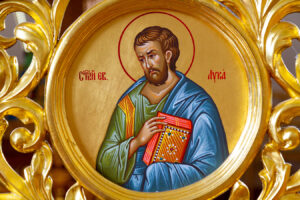By Sister Eloise Rosenblatt
I subscribe to a monthly magazine, Poets and Writers. One feature, “Where New and Noteworthy Books Begin,” has a page listing intriguing opening sentences. For example, a poetry collection begins: “It matters where you are born.” And another: “I can’t undo all I have done to myself,/ what I have let an appetite for love do to me.” A novel: “Where are you from?”

Luke’s famous “first sentence” is called his Prologue. His gospel begins with a disclosure: “This is who I am,” a historian and truth-teller. He distinguishes himself from previous tellers of the story about Jesus. As a researcher and verifier of facts, he addresses his reader’s spiritual need for reassurance: “I too decided, after investigating everything carefully, from the very first, to write an orderly account for you, most excellent Theophilus, so that you may know the truth concerning the things about which you have been instructed.” (Lk. 1: 3)
Luke wants readers to know he’s a real person who collected written records that he has personally verified. He’s not writing his personal memoir, a fictional adventure novel, gossipy stories about Roman emperors, or transmitting messages from the gods as an oracle or seer. He intends to present an “orderly account” of what the community of faith already knows about Jesus of Nazareth. So the first question I can ask myself is, “Who am I, the reader? Where am I in my own spiritual life?”
The story of Jesus begins with several starting points. The first is the Prologue. The second is: “In the days of King Herod of Judea, there was a priest named Zechariah who belonged to the priestly order of Abijah….” (1:5) He cites a particular place and calendar time, along with tribal history. “Abijah” refers to a Jewish tribal branch going back centuries. Then we have several mini-starts.
The calendar year is not a month, but the name of the regional Jewish ruler—Herod. This refers to a political era of Roman occupation and oppression. Judea is the geographical territory where the holy city Jerusalem and its temple stand.
Luke focuses on a particular ritual moment during a major Jewish festival. We can measure the minutes Zechariah walks into the interior sanctuary, stands before the altar, lights the taper, and begins the burning of small nodules and lumps of incense, the fragrant resin of plants and trees.
A third beginning is the transportive appearance of Gabriel, and the annunciation to Zachary that his wife Elizabeth will bear him a son (1: 13). Elizabeth becomes pregnant, and Luke notes it is “five months” since her conception, so the “when” becomes gestational time (1:24).
A fourth beginning takes place “in the sixth month,” within the “woman time” of Elizabeth’s conception. Gabriel’s annunciation to Mary takes place in Galilee in the town of Nazareth, to the north of Jerusalem. Luke describes her status: she is unmarried, but betrothed to Joseph. He is a descendant of David, the fabled king who established Jerusalem as the capital of his kingdom and united the tribes into one nation—Galilee and Judea, north and south.
Luke offers us ways to reflect on the starting points for the story of Jesus—the speaker, the place, the historical era, the family, the divine interventions, before he was born. We can also reflect on the “advents” and starts in our own lives.
Who am I, the listener to the story of Jesus and my own story?
What are the various starting places for my story, the when and the where?
What was the spiritual experience of the men and women in my family?
What is the sacred destiny into which I was born?